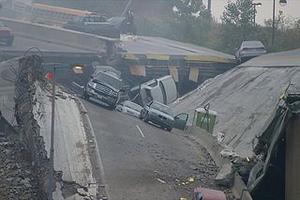Infrastructure protectionNew, affordable instant warnings of bridge collapse
The Federal Bureau of Transportation lists nearly 70,000 U.S. bridges as “structurally deficient,” requiring extra surveillance; in addition, more than 77,000 others are categorized as “obsolete” — exceeding their intended lifespan and carrying loads greater than they were designed to handle; researchers developed a new technology for monitoring these 150,000 aging U.S. highway bridges

The I-35W bridge collapse in Minneapolis // Source: wikipedia.org
On 1 August 2007, without warning, the roadway suddenly disappeared beneath drivers on Minneapolis’ I-35W Bridge. The collapse sent more than 100 cars into the Mississippi River, killing 13 and injuring145.
In the five years since, advances in wireless sensor technology are making warning systems to prevent such tragedies affordable and practical, say engineers at the University of Maryland. A new generation of these devices is needed adequately to monitor the nearly 150,000 U.S. highway bridges — about one in four — listed by the federal government as either “structurally deficient” or “obsolete,” the researchers add.
“We no longer need to roll the dice when it comes to the structural integrity of the nation’s highway bridges,” says University of Maryland research engineer Mehdi Kalantari. “Technical advances in wireless sensors make real-time monitoring both affordable and practical.”
A University of Maryland release reports that Kalantari leads one of two engineering teams at Maryland addressing the need. Working at the university’s Mtech incubator, Kalantari has taken an entrepreneurial route, developing a system of tiny, long-lasting, energy-efficient, low-maintenance wireless sensors and software that analyzes real-time data collected. His startup, Resensys, has manufactured systems for use in the private sector and for testing by Maryland State Highway officials.
Another University of Maryland engineering team, supported by federal and state funding and working with researchers from North Carolina State University and URS Corp., is working on a total “smart bridge” package with multiple technology innovations. Their Integrated Structural Health Monitoring system is not yet available commercially. Key elements of this system, however, are being tested by Maryland State Highway officials, the Maryland Transportation Authority and the North Carolina Department of Transportation.
“Wireless technology definitely makes bridge structural health monitoring more efficient and more effective,” says UMD civil and environmental engineering research professor Chung Fu, director of Maryland’s Bridge Engineering Software & Technology Center and one of the leaders of this second research group.
“If the prices for system hardware and software are further reduced and standardized, we may see more widespread application in the next five to 10 years,” Fu says, adding that he has seen great advancement in this technology in the past decade.
Meanwhile, Kalantari is in the second year of testing his system on a Maryland Interstate bridge along the Capital Beltway in suburban Washington, D.C. Over the past twelve months, he has upgraded his system, making it fully operational, and expanded its
